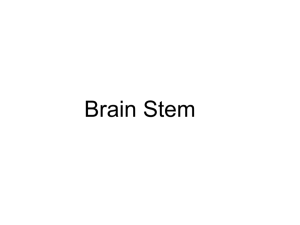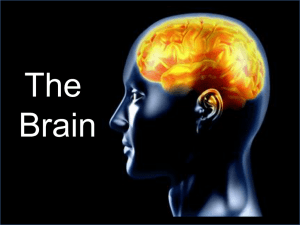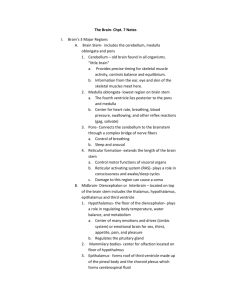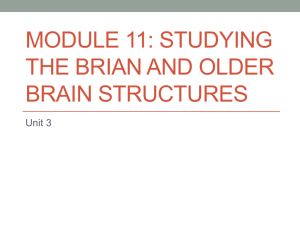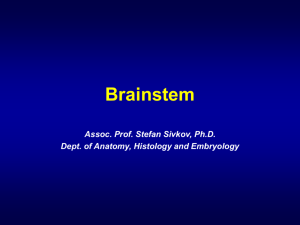Chap 12B
advertisement
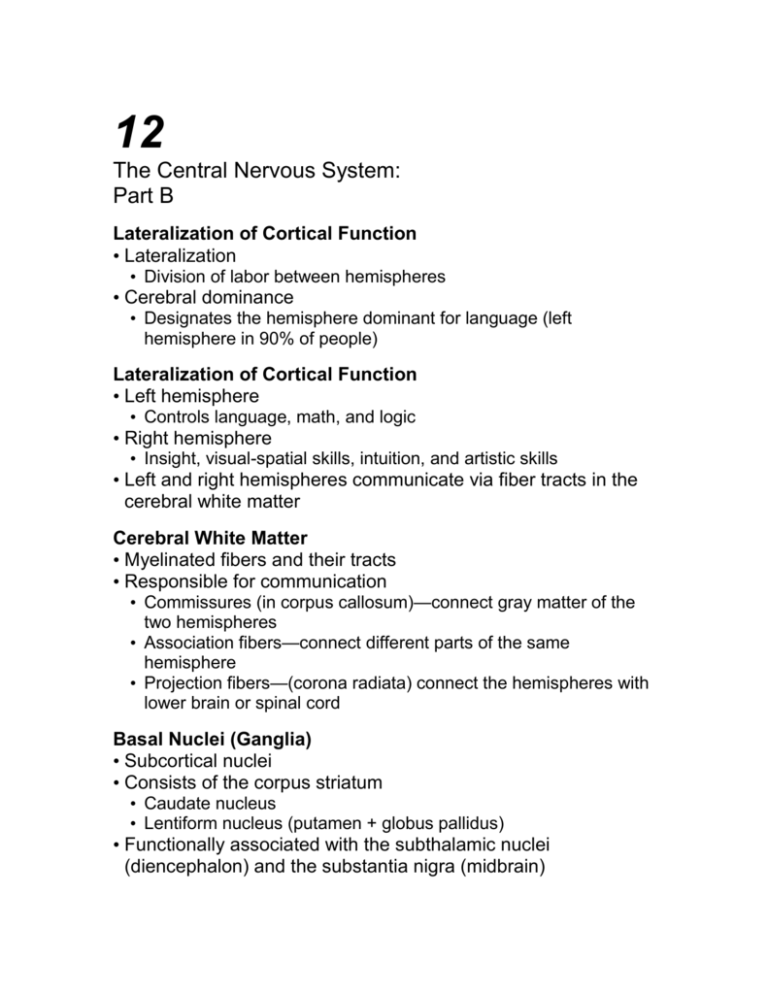
12 The Central Nervous System: Part B Lateralization of Cortical Function • Lateralization • Division of labor between hemispheres • Cerebral dominance • Designates the hemisphere dominant for language (left hemisphere in 90% of people) Lateralization of Cortical Function • Left hemisphere • Controls language, math, and logic • Right hemisphere • Insight, visual-spatial skills, intuition, and artistic skills • Left and right hemispheres communicate via fiber tracts in the cerebral white matter Cerebral White Matter • Myelinated fibers and their tracts • Responsible for communication • Commissures (in corpus callosum)—connect gray matter of the two hemispheres • Association fibers—connect different parts of the same hemisphere • Projection fibers—(corona radiata) connect the hemispheres with lower brain or spinal cord Basal Nuclei (Ganglia) • Subcortical nuclei • Consists of the corpus striatum • Caudate nucleus • Lentiform nucleus (putamen + globus pallidus) • Functionally associated with the subthalamic nuclei (diencephalon) and the substantia nigra (midbrain) Functions of Basal Nuclei • Though somewhat elusive, the following are thought to be functions of basal nuclei • • • • Influence muscular control Help regulate attention and cognition Regulate intensity of slow or stereotyped movements Inhibit antagonistic and unnecessary movements Diencephalon • Three paired structures • Thalamus • Hypothalamus • Epithalamus • Encloses the third ventricle Thalamus • 80% of diencephalon • Superolateral walls of the third ventricle • Connected by the interthalamic adhesion (intermediate mass) • Contains several nuclei, named for their location • Nuclei project and receive fibers from the cerebral cortex Thalamic Function • Gateway to the cerebral cortex • Sorts, edits, and relays information • Afferent impulses from all senses and all parts of the body • Impulses from the hypothalamus for regulation of emotion and visceral function • Impulses from the cerebellum and basal nuclei to help direct the motor cortices • Mediates sensation, motor activities, cortical arousal, learning, and memory Hypothalamus • Forms the inferolateral walls of the third ventricle • Contains many nuclei • Example: mammillary bodies • Paired anterior nuclei • Olfactory relay stations • Infundibulum—stalk that connects to the pituitary gland Hypothalamic Function • Autonomic control center for many visceral functions (e.g., blood pressure, rate and force of heartbeat, digestive tract motility) • Center for emotional response: Involved in perception of pleasure, fear, and rage and in biological rhythms and drives Hypothalamic Function • Regulates body temperature, food intake, water balance, and thirst • Regulates sleep and the sleep cycle • Controls release of hormones by the anterior pituitary • Produces posterior pituitary hormones Epithalamus • Most dorsal portion of the diencephalon; forms roof of the third ventricle • Pineal gland—extends from the posterior border and secretes melatonin • Melatonin—helps regulate sleep-wake cycles Brain Stem • Three regions • Midbrain • Pons • Medulla oblongata Brain Stem • Similar structure to spinal cord but contains embedded nuclei • Controls automatic behaviors necessary for survival • Contains fiber tracts connecting higher and lower neural centers • Associated with 10 of the 12 pairs of cranial nerves Midbrain • Located between the diencephalon and the pons • Cerebral peduncles • Contain pyramidal motor tracts • Cerebral aqueduct • Channel between third and fourth ventricles Midbrain Nuclei • Nuclei that control cranial nerves III (oculomotor) and IV (trochlear) • Corpora quadrigemina—domelike dorsal protrusions • Superior colliculi—visual reflex centers • Inferior colliculi—auditory relay centers • Substantia nigra—functionally linked to basal nuclei • Red nucleus—relay nuclei for some descending motor pathways and part of reticular formation Pons • Forms part of the anterior wall of the fourth ventricle • Fibers of the pons • Connect higher brain centers and the spinal cord • Relay impulses between the motor cortex and the cerebellum • Origin of cranial nerves V (trigeminal), VI (abducens), and VII (facial) • Some nuclei of the reticular formation • Nuclei that help maintain normal rhythm of breathing Medulla Oblongata • Joins spinal cord at foramen magnum • Forms part of the ventral wall of the fourth ventricle • Contains a choroid plexus of the fourth ventricle • Pyramids—two ventral longitudinal ridges formed by pyramidal tracts • Decussation of the pyramids—crossover of the corticospinal tracts Medulla Oblongata • Inferior olivary nuclei—relay sensory information from muscles and joints to cerebellum • Cranial nerves VIII, X, and XII are associated with the medulla • Vestibular nuclear complex—mediates responses that maintain equilibrium • Several nuclei (e.g., nucleus cuneatus and nucleus gracilis) relay sensory information Medulla Oblongata • Autonomic reflex centers • Cardiovascular center • Cardiac center adjusts force and rate of heart contraction • Vasomotor center adjusts blood vessel diameter for blood pressure regulation Medulla Oblongata • Respiratory centers • Generate respiratory rhythm • Control rate and depth of breathing, with pontine centers Medulla Oblongata • Additional centers regulate • • • • • Vomiting Hiccuping Swallowing Coughing Sneezing The Cerebellum • 11% of brain mass • Dorsal to the pons and medulla • Subconsciously provides precise timing and appropriate patterns of skeletal muscle contraction Anatomy of the Cerebellum • Two hemispheres connected by vermis • Each hemisphere has three lobes • Anterior, posterior, and flocculonodular • Folia—transversely oriented gyri • Arbor vitae—distinctive treelike pattern of the cerebellar white matter Cerebellar Peduncles • All fibers in the cerebellum are ipsilateral • Three paired fiber tracts connect the cerebellum to the brain stem • Superior peduncles connect the cerebellum to the midbrain • Middle peduncles connect the pons to the cerebellum • Inferior peduncles connect the medulla to the cerebellum Cerebellar Processing for Motor Activity • Cerebellum receives impulses from the cerebral cortex of the intent to initiate voluntary muscle contraction • Signals from proprioceptors and visual and equilibrium pathways continuously “inform” the cerebellum of the body’s position and momentum • Cerebellar cortex calculates the best way to smoothly coordinate a muscle contraction • A “blueprint” of coordinated movement is sent to the cerebral motor cortex and to brain stem nuclei Cognitive Function of the Cerebellum • Recognizes and predicts sequences of events during complex movements • Plays a role in nonmotor functions such as word association and puzzle solving




